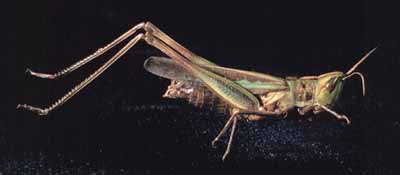
(Syrbula admirabilis)
Interesting facts:
The ears on this species of grasshopper (and many other short-horned grasshoppers) are located on the sides of the abdomen, just behind the base of the hind legs. The ear looks like a tiny moveable drum head, but it can only be seen under a microscope.
Location in Illinois:
It is found in many parts of Illinois where there are grasslands.
Description:
Illinois slant-faced grasshoppers average about 25-39 mm. long. Females are mostly green with brown markings. Males are dark brown with a yellowish-white stripe. Its slim body blends in with blades of grass. Wings allow it to move from one area of grass to another. The handsome grasshopper makes a rasping noise by rubbing the base of its forewings against the inner edge of the femur (upper section) of each hind leg. Large flat mouthparts, called mandibles, chew the blades of grass that are its diet.
Habitat and behavior:
Slant-face grasshoppers live in grasslands, wet meadows, and prairie remnants. Grasshoppers live for one season, from hatching in the spring until cold weather in the fall. Eggs are laid in the soil. They over-winter in the soil and hatch into nymphs in the spring. The nymph is a tiny version of the adult, but has no wings. It goes through five stages of growth, shedding its exoskeleton at each stage. At the end of two to three months, it is of adult size and has wings. A male and female mate and the female lays eggs in the soil. Then, the adults die.
Food:
The nymphs and adults eat big bluestem (Adropogen gerardii) and other grasses.
Predators:
Predators of grasshoppers are many kinds of birds found in prairie areas, including the Greater Prairie Chicken, Henslow's Sparrow, and the Eastern Meadowlark.
Distribution and status:
The slant-faced grasshopper is found from Iowa to Pennsylvania, south to Florida, west to Arizona, and into Mexico. This species has adapted to new habitats as the prairie disappeared.